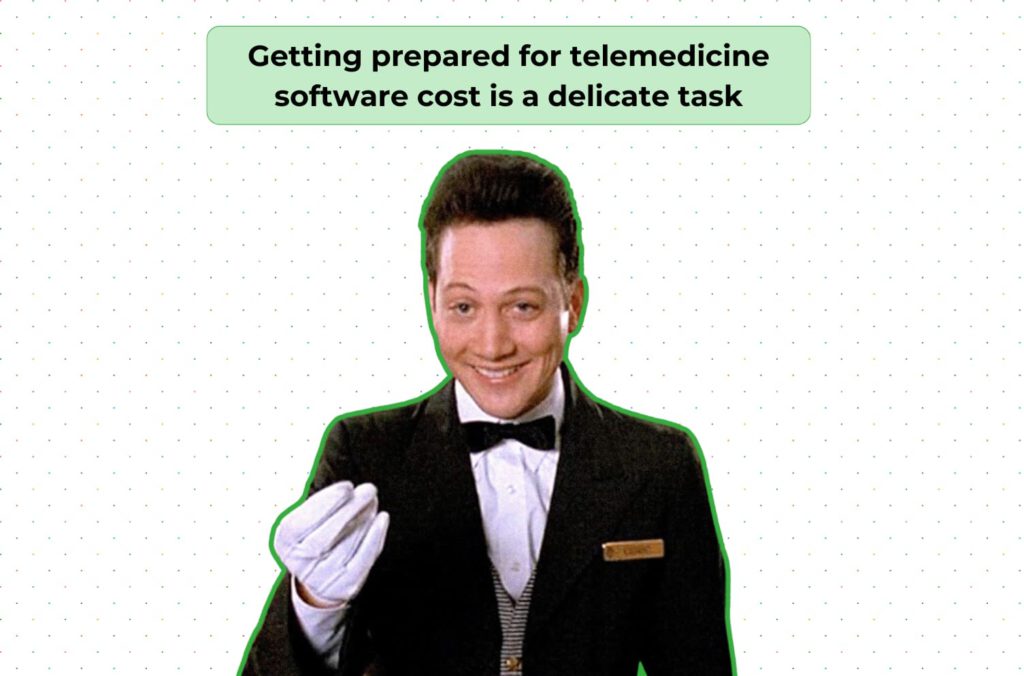How to start a telemedicine practice: main software challenges

The landscape of healthcare has undergone a seismic shift, with telemedicine emerging as a transformative force catalyzed by the COVID-19 pandemic. No wonder telemedicine, which provides remote healthcare services, utilizes digital communication technologies to facilitate consultations between patients and healthcare professionals, became one of the trends after the said crisis. The convenience it offers has catapulted telemedicine to unbelievable popularity.
Some interesting figures: Virtual care is used 38 times higher than before the COVID-19 pandemic, as reported by McKinsey. At the same time, according to analytics by J.D. Power, the vast majority (94%) of patients and their families who received medical services through a telehealth provider “definitely will” or “probably will” use telehealth to receive medical services in the future. Plus, according to the ResearchGate report, the majority (52.5%) of clinicians reported higher efficiency of telehealth virtual video visits and follow-ups.

So, this is where the healthcare industry is going. Convenience and time-saving. Telemedicine addresses healthcare needs, bringing medical expertise directly to patients’ homes. It leverages a spectrum of tools, including video calls, messaging apps, and secure online platforms, involving AI and IoT to bridge the geographical gap between healthcare providers and those seeking medical guidance.
However, it becomes apparent that the heart of this transformation lies in overcoming the software challenges. This article will navigate through the essential steps and challenges, shedding light on the intricacies of software integration for a successful telemedicine practice.
How to start a telemedicine practice?
Before diving into the complexities of telemedicine software, it’s crucial to understand the fundamental steps involved in starting a telemedicine practice. To that end, you can look through our telemedicine software pre-development steps we enlightened in the previous article. The transition from traditional healthcare delivery to a virtual model requires careful consideration of various requirements.

Requirements for starting a telemedicine practice
- Licensing and credentialing: appropriate licenses should be obtained. Additionally, compliance with state licensing laws should be ensured. Eventually, the credentialing process has to be made clear for telehealth practitioners.
- Technology infrastructure: a trustworthy and secure telemedicine platform that aligns with the needs of your practice shall be selected. Plus, reliable internet connectivity, high-quality cameras, and audio equipment shall be provided to facilitate exceptional virtual consultations.
- Staff training: healthcare professionals shall be trained comprehensively, and staff shall be supported enough to effectively navigate telemedicine platforms and protocols.
- Patient education: patients shall be educated about the telehealth services offered, including appointment scheduling, virtual waiting rooms, and user-friendly telemedicine applications shall be a good fit here.
- Telemedicine policies: telemedicine policies and procedures covering issues such as privacy, security, scheduling, and emergency protocols shall be prepared and implemented.
Main telemedicine challenges related to software
From ensuring stringent security measures and compliance with healthcare regulations to managing the financial aspects and integrating with existing healthcare systems, telemedicine practice start brings with it a set of barriers primarily centered around software implementation. The telemedicine software challenges require deep attention and strategic solutions for a successful and patient-centric virtual healthcare experience and secure development lifecycle. So, let’s consider possible issues first:
- HIPAA compliance and security measures
Health Insurance Portability and Accountability Act (HIPAA) compliance is paramount when dealing with healthcare data, even in a telemedicine setting. Patient information privacy and security are non-negotiable, and adherence to HIPAA regulations is mandatory. Failure to comply with these regulations can lead to severe legal consequences and erode patient trust. That’s why data security, privacy, and governance are that important.
- Telemedicine software cost

The financial aspect of implementing telemedicine cannot be overlooked. The costs associated with telemedicine software can vary widely, from off-the-shelf solutions to custom-developed platforms. It’s crucial for practitioners to understand the budgetary implications and weigh them against the benefits of implementing telemedicine in their practice by analyzing their and patient needs. Moreover, striking a balance between budget constraints and the need for high-quality, secure software is a delicate task to be taken into account thoroughly.
- Custom telemedicine development
Another challenge lies in the complicated process of designing and implementing a bespoke solution that smoothly integrates with existing data and workflows, addresses specific clinical requirements, and ensures optimal user experiences for both healthcare professionals and patients. The endeavor presents an unparalleled opportunity to create a telemedicine platform that not only meets the distinctive demands of the healthcare practice but also offers long-term scalability and adaptability.
- Implementation of EMR integration solutions
Many healthcare practices rely on Electronic Medical Records (EMR) systems. Integrating telemedicine seamlessly with existing EMR systems is critical for ensuring the overall efficiency of healthcare delivery, maintaining complete patient records, and streamlining administrative processes. This compatibility causes medical records to remain comprehensive and easily accessible, irrespective of the treatment mode.
Overcoming telemedicine software challenges
Once the probable challenges have been discovered, it’s time to learn how to address them effectively.
- HIPAA-compliant telehealth software
In the healthcare industry, patient and their data are foundational. Choosing or developing a telehealth software solution explicitly designed for HIPAA compliance is the first line of defense. This includes features such as secure video conferencing, encrypted messaging, strict user authentication, and access controls to safeguard patient information. The second line of defense shall be regular security assessments and audits that help identify vulnerabilities in telemedicine platforms. Establishing protocols for data breach response and implementing continuous security updates are essential for mitigating risks.
- Optimizing budget for telehealth software solutions
Speaking of resources, it is necessary to reach the best price-quality ratio. Here, we encourage defining requirements clearly, analyzing the market, evaluating vendor reputation, and conducting a thorough needs assessment to identify essential features and functionalities, allowing for a focused investment that aligns with the unique requirements of your healthcare practice. A comprehensive cost-benefit analysis of various telemedicine options, including off-the-shelf, custom, and open-source solutions, helps to pinpoint the most cost-effective and value-driven choice.
- Custom telehealth solutions
There would be no better solution than a customized one. The investment in custom telehealth development positions you to deliver high-quality, patient-centric virtual care that aligns precisely with your vision and operational requirements. Custom software development best practices shall be executed here. From mobile accessibility to self-service analytics and reporting, every detail shall be thought out so that users can access services on various platforms with a mobile-friendly interface, and clinicians can track and manage key performance indicators, patient engagement metrics, and other relevant data.
- Seamless integrated telehealth solutions
When software has been developed or selected, the next thing should be integration with existing infrastructure, EHR/EMR systems, etc. This integration ensures a smooth transition to telemedicine without disrupting the established workflows within the healthcare practice. It is supposed to consider the following steps in the integration process:
- Ensuring that both the telemedicine software and existing EHR/EMR systems comply with interoperability standards;
- Leveraging Application Programming Interfaces (APIs) to establish a secure and standardized connection;
- Developing a mapping strategy to align data structures between the telemedicine software and the EHR/EMR system;
- Conducting thorough testing and validation throughout the integration process;
- Establishing a plan for ongoing maintenance and updates to address any changes.
Conclusion: digital telehealth solutions can benefit your business
Some more interesting figures: According to Statista, as of 2019, the telemedicine global market was valued at some 50 billion U.S. dollars. The market was forecast to grow significantly in the future when it was projected to be valued at nearly 460 billion U.S. dollars by 2030.
These predictions underscore the economic significance of telemedicine, emphasizing its potential to be a cornerstone of the healthcare industry in the years to come. As healthcare businesses continue to invest in and refine their digital telehealth capabilities, they stand to reap the rewards of improved patient satisfaction, expanded reach, and a sustainable model of healthcare delivery. It’s high time to take this transformative step towards shaping the future of healthcare. Contact us, and we will assist you in figuring this out.






